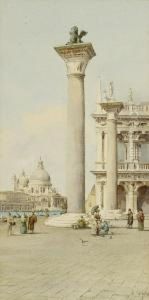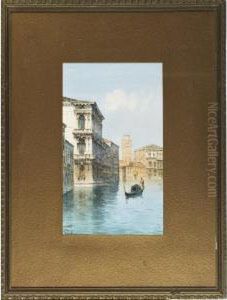Carlo Giuseppe Saletta Paintings
Carlo Giuseppe Saletta, an Italian architect and painter, was born in 1667 and left an indelible mark on the Baroque landscape of Italy before his death in 1729. Saletta's work is less widely known compared to some of his contemporaries, yet his contributions to the architectural and artistic heritage of Italy during the late 17th and early 18th centuries are noteworthy. His career encapsulates the transition from the High Baroque to the early Rococo, reflecting the evolving aesthetic preferences of his time.
Saletta's journey into the arts commenced in his native Italy, where he was deeply influenced by the grandeur of Baroque architecture and the emerging Rococo style, characterized by its lightness, grace, and use of delicate ornamentation. His architectural works often blended these two styles, creating spaces that were both majestic and elegantly detailed. Though primarily celebrated as an architect, Saletta's talents also extended to painting, where he exhibited a keen eye for detail and a profound understanding of the interplay of light and shadow, hallmarks of the Baroque artistic language.
Throughout his career, Saletta was involved in several significant projects, including the design and construction of churches, palaces, and public buildings in various Italian cities. These works were marked by their dramatic use of space, movement, and innovative use of light, embodying the theatricality so beloved by the Baroque sensibility. In addition to his architectural endeavors, Saletta's paintings, which often depicted religious and mythological scenes, were celebrated for their emotional intensity and dynamic compositions.
Despite his achievements, Carlo Giuseppe Saletta's name is not as prominently featured in the annals of art history as some of his peers. This oversight may be attributed to the limited geographical scope of his work or the overshadowing fame of contemporaries like Gian Lorenzo Bernini and Francesco Borromini. Nevertheless, Saletta's legacy endures through his contributions to the architectural and artistic landscapes of Italy, where his works continue to inspire admiration and scholarly interest.
Saletta's death in 1729 marked the end of an era that bridged the grandeur of the Baroque with the emerging delicacy of the Rococo. Today, his works serve as a testament to the creativity and innovation of early modern Italian art and architecture, embodying the spirit of an age that sought to balance the dramatic and the delicate. Saletta's life and career remind us of the richness of Italy's artistic heritage and the myriad talents that have shaped its cultural landscape.

